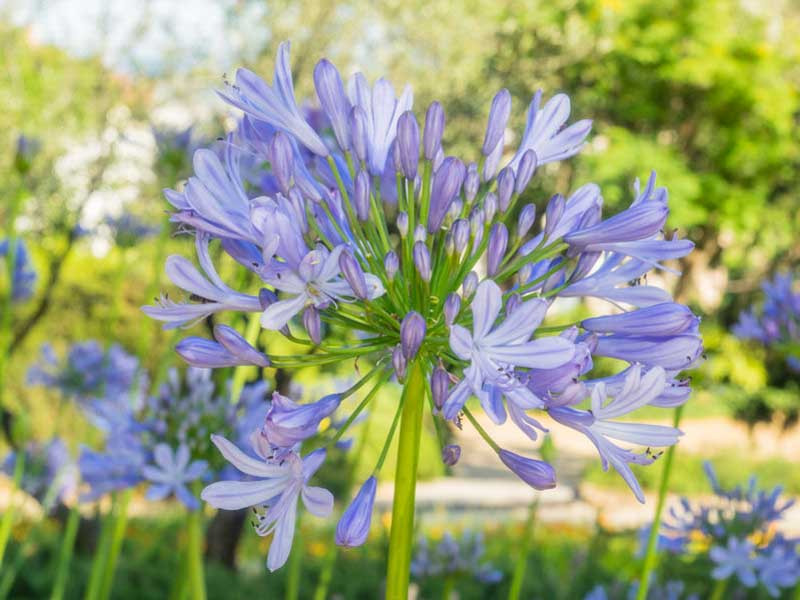Agapanthus Breeding: Tips for Expanding Your Plant Collection
Agapanthus Breeding: Tips for Expanding Your Plant Collection
Blog Article
Understanding the Art of Agapanthus Treatment: Essential Actions for Healthy And Balanced Development and Lively Blooms
In the world of cultivation, the farming of agapanthus stands as a gratifying venture for those that seek to nurture these elegant flowering plants. With their striking blooms and stylish foliage, agapanthus has actually captured the focus of garden enthusiasts worldwide. Nevertheless, accomplishing optimal development and dynamic blooms calls for a nuanced technique that encompasses numerous crucial steps. From picking the ideal range to grasping pruning strategies, the trip in the direction of cultivating flourishing agapanthus plants is complex and holds the crucial to unlocking the full potential of these herb gems.

Picking the Right Agapanthus Variety

When selecting the appropriate Agapanthus range for your yard, consider elements such as environment viability, bloom color, and development habit. Furthermore, take into consideration the environment in your area to guarantee the Agapanthus range you pick can flourish in your details conditions. Recognizing the growth behavior of different Agapanthus ranges is critical for correct positioning within your garden.
Suitable Growing Problems
Considering the ideal environmental requirements is necessary for successful Agapanthus growing. Agapanthus prospers in well-draining dirt with a slightly acidic to neutral pH level. When growing, select a location that gets full sunshine to partial shade. In hotter climates, providing some afternoon shade can stop scorching of the leaves. Agapanthus plants are delicate to chilly temperature levels and need to be shielded from frost throughout winter months.
To make certain healthy and balanced growth and dynamic blooms, plant Agapanthus bulbs at a deepness of about 2-4 inches and space them 8-12 inches apart. Including natural matter, such as garden compost, to the soil can boost water drainage and fertility, promoting durable root advancement. Mulching around the base of the plants assists preserve moisture and reduces weed growth. Regular watering is essential, particularly during the expanding season, to maintain the dirt constantly moist but not saturated.
Watering and Feeding Tips
Keeping proper moisture levels and giving vital nutrients are vital aspects in the treatment routine for Agapanthus plants. When it comes to watering Agapanthus, it is critical to strike a balance. These plants prefer constantly moist dirt but are prone to root rot if overwatered.
Fertilizing Agapanthus is necessary for advertising healthy and balanced development and respected blooms. Use a balanced plant food, such as a 10-10-10 formula, in the very early springtime as new development arises. By following these watering and feeding tips, you can ensure your Agapanthus plants grow and produce vibrant, lasting blooms.
Pruning Strategies for Agapanthus
Trimming Agapanthus plants at the suitable times and with correct strategies is essential for maintaining their health and advertising optimum growth and blooming. The excellent time to prune Agapanthus is in late winter season or very early springtime before brand-new development arises.
For flowered stems, wait till the blooms have withered and after that cut them back to the base. This not only tidies up the plant's appearance but also urges the development of brand-new flower buds. Deadheading spent blossoms can additionally redirect the plant's power right into producing more blooms as opposed to setting seeds. Nevertheless, if you wish to gather seeds for proliferation, leave some blossoms to fully grown and completely dry on the plant.
Bear in mind to utilize clean, sharp tools to make accurate cuts and minimize the threat of presenting illness. Agapanthus. Normal trimming will certainly aid maintain your Agapanthus looking healthy and neat while guaranteeing a plentiful screen of stunning blooms
Taking Care Of Typical Bugs and Illness
After making certain appropriate trimming strategies for Agapanthus, it is vital to his comment is here address usual pests and illness that can influence the health and vitality of these plants. Agapanthus plants are normally hardy however can still come down with certain concerns. One common parasite that affects Agapanthus is the Agapanthus gall midget. This little, orange fly lays its eggs in the foliage, resulting in distorted development and blossom buds that fail to open. To read here battle this pest, prune and damage any type of afflicted plant components and take into consideration making use of insecticidal soap.
In addition, Agapanthus plants can suffer from origin rot if they are planted in poorly draining pipes dirt. By being watchful and taking prompt action against illness and parasites, you can aid your Agapanthus plants flourish and create dynamic blossoms. Agapanthus.

Conclusion
To conclude, mastering the art of agapanthus care includes choosing the ideal variety, giving optimal planting problems, appropriate watering and fertilizing, ideal trimming methods, and attending to usual insects and conditions. By adhering to these vital steps, you can make sure healthy growth and dynamic blooms for your agapanthus plants. Keep in mind to on a regular basis monitor and keep your plants to promote their overall wellness and durability.
To guarantee healthy growth and vivid blooms, plant Agapanthus light bulbs at a depth my site of regarding 2-4 inches and room them 8-12 inches apart. By adhering to these watering and feeding suggestions, you can ensure your Agapanthus plants grow and produce lively, long-lasting blooms.
One common pest that influences Agapanthus is the Agapanthus gall midget. Additionally, Agapanthus plants can suffer from root rot if they are planted in improperly draining pipes dirt. By adhering to these vital steps, you can guarantee healthy and balanced growth and vivid blooms for your agapanthus plants.
Report this page